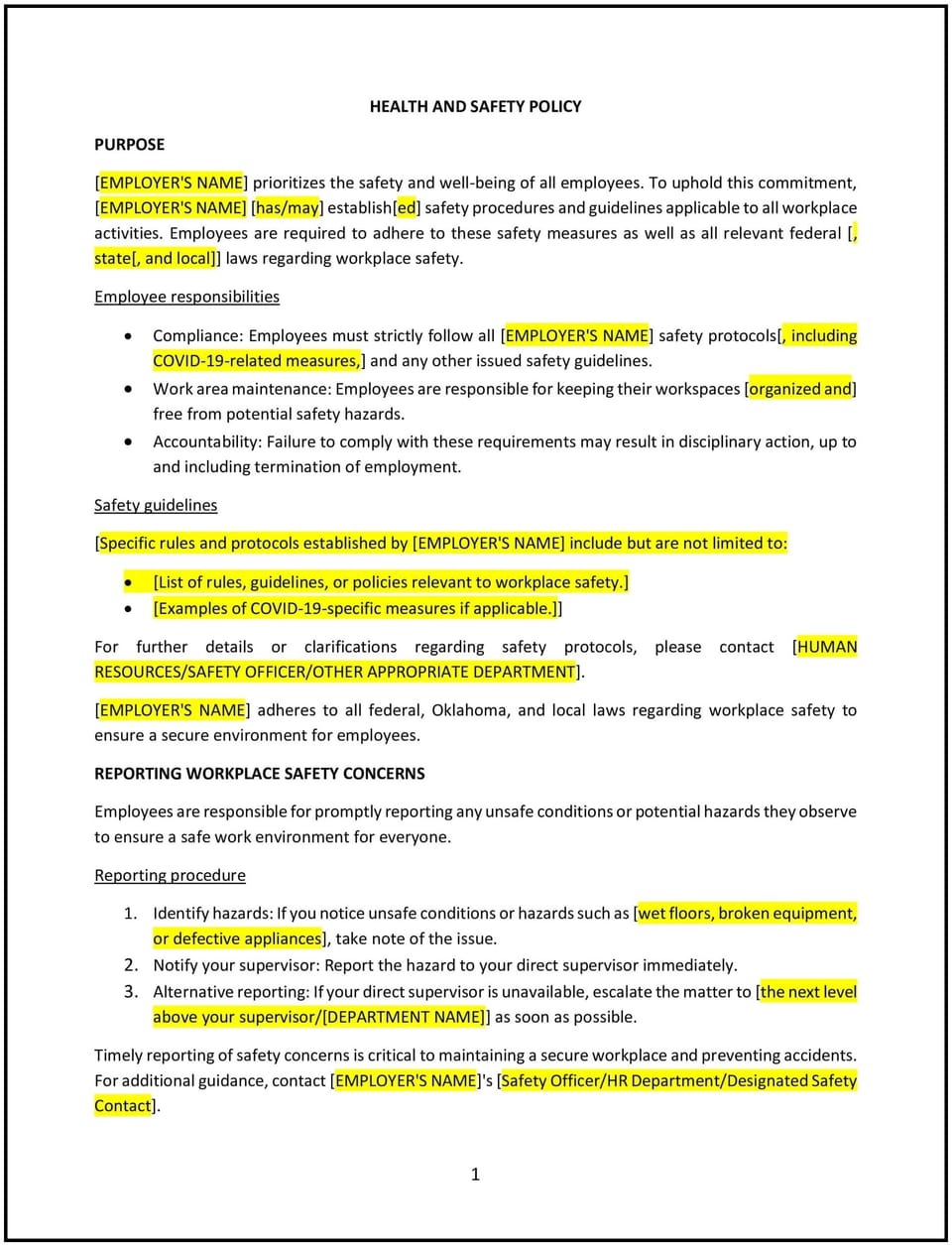Health and safety policy (Oklahoma): Free template

Health and safety policy (Oklahoma)
This health and safety policy is designed to help Oklahoma businesses create and maintain a safe working environment for all employees. The policy outlines workplace safety expectations, risk management procedures, and employee responsibilities to prevent accidents and health hazards.
By implementing this policy, businesses can reduce workplace injuries, promote a safety-conscious culture, and strengthen compliance with occupational health standards.
How to use this health and safety policy (Oklahoma)
- Define workplace safety expectations: Establish general safety responsibilities for employees, supervisors, and management.
- Identify workplace hazards: Conduct risk assessments to identify and mitigate potential safety risks.
- Establish emergency procedures: Outline evacuation plans, fire safety protocols, and medical emergency response steps.
- Provide training and education: Require safety training for employees, including proper equipment use and emergency response.
- Implement reporting mechanisms: Allow employees to report hazards or incidents without fear of retaliation.
- Set personal protective equipment (PPE) requirements: Define when and where safety gear is necessary.
- Review regularly: Assess workplace conditions and update the policy to reflect changes in regulations and business operations.
Benefits of using this health and safety policy (Oklahoma)
Implementing this policy provides several advantages for Oklahoma businesses:
- Reduces workplace injuries: Minimizes risks associated with hazardous conditions and unsafe practices.
- Promotes a culture of safety: Encourages proactive hazard reporting and employee involvement in safety initiatives.
- Improves operational efficiency: Prevents workplace disruptions caused by accidents or health-related incidents.
- Supports compliance with safety regulations: Helps businesses align with Oklahoma’s occupational safety laws.
- Reflects Oklahoma-specific workplace considerations: Addresses regional safety concerns, such as extreme weather risks.
Tips for using this health and safety policy (Oklahoma)
- Conduct regular safety audits: Identify potential hazards and implement corrective measures.
- Encourage employee participation: Foster a safety culture where employees actively report concerns.
- Maintain proper safety records: Document incidents, training sessions, and compliance measures.
- Provide accessible first aid stations: Ensure first aid kits and medical emergency resources are available.
- Adjust policies as needed: Update safety procedures based on industry best practices and legal updates.
Q: What are the key components of a workplace health and safety policy?
A: Businesses should include hazard identification, emergency procedures, safety training, and reporting mechanisms.
Q: How can businesses promote a culture of safety?
A: Businesses should provide ongoing safety training, encourage employee feedback, and recognize proactive safety efforts.
Q: What should employees do if they notice a safety hazard?
A: Businesses should require employees to report hazards to supervisors or safety officers immediately.
Q: Are businesses required to provide safety training?
A: Yes, businesses should ensure employees receive training on workplace hazards, emergency protocols, and equipment use.
Q: How should businesses respond to workplace injuries?
A: Businesses should follow incident reporting procedures, provide medical attention, and document the event for future prevention.
Q: What role do managers play in workplace safety?
A: Managers should enforce safety protocols, conduct inspections, and ensure employees follow proper procedures.
Q: How often should this policy be reviewed?
A: The policy should be reviewed annually or as needed to align with changes in workplace safety regulations.
This article contains general legal information and does not contain legal advice. Cobrief is not a law firm or a substitute for an attorney or law firm. The law is complex and changes often. For legal advice, please ask a lawyer.


